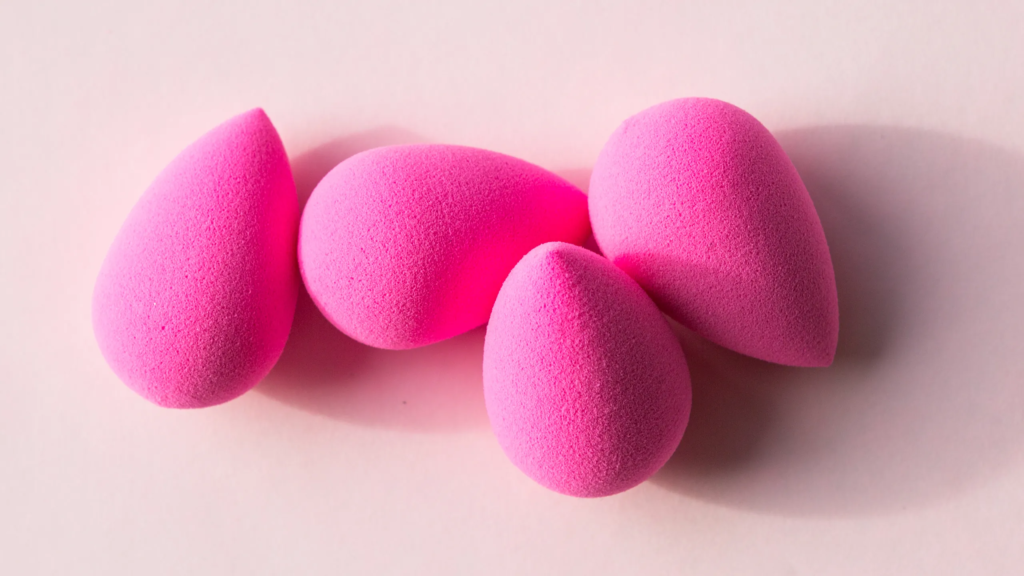In the vast universe of beauty tools, few have sparked a revolution quite like the humble makeup sponge. Gone are the days when a wedge of foam was your only option. Today’s makeup sponges are ergonomic, high-tech, and promise a airbrushed finish that brushes and fingers simply can’t replicate.
But with so many shapes, sizes, and brands on the market, how do you choose? And are you even using it correctly? Let’s dive into the squishy, fascinating world of makeup sponges and unlock the secrets to a perfect application.
Why Choose a Sponge Over a Brush?
The debate between sponge and brush is a classic, but it’s not about which is better—it’s about which is better for the finish you desire.
Sheer, Dewey, & Skin-Like: Sponges are the undisputed champions of a natural, “my skin but better” look. They sheer out product, preventing a heavy, cakey appearance and allowing your skin’s natural texture to glow through.
Blends Seamlessly: The bouncy, porous material helps to press and stipple product into the skin, melting foundation and concealer for a boundary-free blend.
Perfect for Liquid & Cream Products: Sponges excel with liquid foundations, cream blushes, and liquid highlighters, absorbing just enough to distribute product evenly without wasting it.
Brushes, on the other hand, are fantastic for a more full-coverage, polished, and matte finish. Think of it as this: sponges for skin-like realism, brushes for perfected artistry.
The Anatomy of a Great Makeup Sponge

Not all sponges are created equal. When shopping, look for these key features:
Material: High-quality sponges are made from hydrophilic foam, meaning they absorb water. When wet, they expand significantly and become incredibly soft.
Shape: This is where innovation shines.
The Teardrop (Beautyblender Classic): The original shape. The rounded bottom is for large areas like cheeks and forehead, the precise pointed tip gets under eyes and around the nose, and the flat edge can be used for pressing in product.
The Multi-Faceted (e.l.f. Cosmetics, Juno & Co.): These feature various flat edges and curves designed to fit every contour of the face, making application intuitive.
The Silicone Sponge: A non-porous option that doesn’t absorb product, theoretically leading to less waste. However, they don’t blend the same way and can slide product around rather than pressing it in.
Texture: It should feel soft and smooth, not rough or crumbly. A denser sponge might absorb less product, while a softer one might offer a more delicate blend.
How to Use Your Makeup Sponge: The Right Way
This is the most crucial part. Using a sponge incorrectly is the main reason people feel they “waste product” or don’t get good results.
Step 1: GET IT WET!
This is non-negotiable. Run your sponge under water until it is completely saturated. Squeeze it out until it stops dripping. Then, squeeze it again in a clean towel. A damp sponge is the key to success. It prevents the sponge from absorbing too much of your foundation and helps to sheer it out for a natural finish.
Step 2: Apply Your Product.
Don’t put product directly onto the dry sponge—it will soak it right up. Instead, place your foundation or concealer onto the back of your hand (your “palette”) or dot it directly onto your face.
Step 3: BOUNCE, Don’t Drag.
This is the signature move. Using the damp sponge, gently bounce or stipple the product onto your skin. Use a pressing and lifting motion. Avoid dragging or wiping, as this can create streaks and disrupt any underlying skincare or primer.
Step 4: Build Coverage.
Start with a thin layer and bounce over areas where you need more coverage. The beauty of a sponge is its buildable nature. For under-eyes, use the precise tip to gently pat and blend concealer.
Cleaning & Care: Making Your Sponge Last
A dirty sponge is a breeding ground for bacteria that can cause breakouts. Clean it regularly!
Weekly Deep Clean: Use a dedicated solid or liquid sponge cleanser. Wet the sponge, apply cleanser, and massage it under running water until the water runs clear and no more product is being squeezed out.
Quick Clean (Between Uses): A spritz of brush cleaning spray or gentle soap can help freshen it up.
Replace Regularly: Even with perfect cleaning, sponges wear out. Replace them every 1-3 months, or if you notice tears, a permanent stain, or a funky smell that won’t wash out.
The Great Debate: Are Dupes Just as Good as the Beautyblender?
The original Beautyblender is the gold standard, but its price tag ($20) leads many to seek alternatives. The good news? There are incredible dupes available at the drugstore (from brands like Real Techniques, e.l.f., and Shop Miss A) that perform 90% as well for a fraction of the cost. The differences are often minimal—perhaps a slight variance in density or longevity. For most people, a high-quality dupe is a fantastic and affordable option.
Final Verdict
The makeup sponge is more than just a trend; it’s a tool that democratized a flawless, natural-looking base for everyone. Whether you invest in the iconic pink egg or a beloved drugstore dupe, mastering the art of the damp bounce will forever change your makeup game. So grab your sponge, get it wet, and get ready to bounce your way to beautiful, seamless skin.

